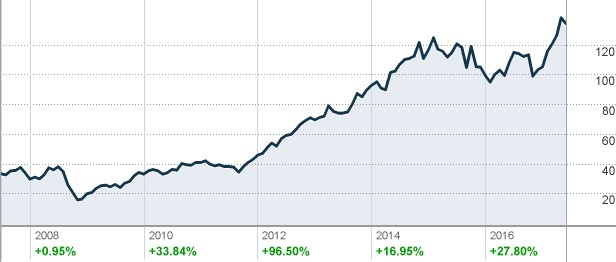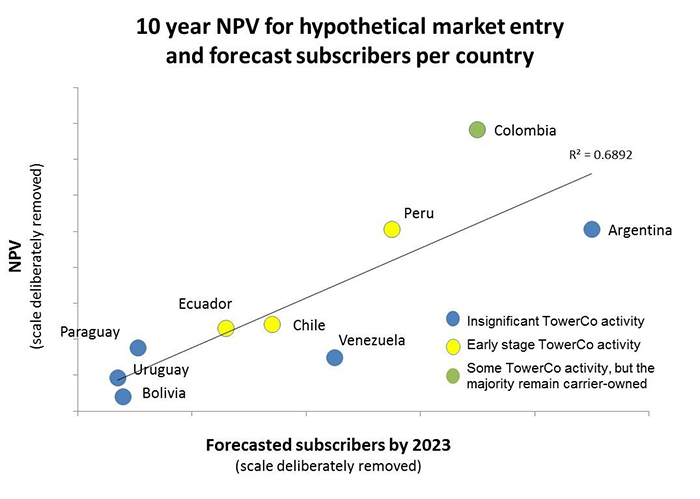The U.S. wireless market is already mature, so giants like AT&T are looking south, where the revolution is still in the throes of profitability and billionaires are now being minted. But the best opportunity is a $75.6-billion niche market that forms the backbone of the wireless industry.
Few investors have even caught on to this segment yet, but three companies in this most profitable niche have already seen crazy 10-year returns, and combined they have risen to a market cap of more than $100 billion—and they're just getting started.
The fourth is the only entry point into this explosive market.
The market is cell towers, and the entry point is Tower One Wireless (CNX:TO; OTC: TOWTF)
This industry no longer suffers from skeptics, like it did when Ronald Reagan gave away tons of service provider licenses in the 1980s and major investors mocked wireless communications as something that had no mass appeal. Those who saw the future in this became billionaires.
The same thing is now unfolding in Latin America, but the playing field is fiercely competitive—except in this one special niche. Cell towers are the fastest and purest route to profit, and there are only four publicly traded independent cell tower companies in the entire world.
And they all started from scratch, so the other three larger companies have no advantage over small-cap Tower One. This playing field is level, and its explosive—in fact, it's so explosive that SBA Communications (NASDAQ:SBAC) handed its investors a whopping 44,566 percent return.
SBA Communication (SBAC) 10-Year Returns

Source: CNN Money
Tower One (CNX:TO; OTC: TOWTF) is the next in line, and it's targeting wireless-hungry South America. And it's not alone in targeting this venue—for good reason. AT&T is pouncing on South America—particularly Mexico--for growth because the U.S. market is already mature.
Across segments, rapid wireless subscriber growth and heavy investments in LTE rollout make Latin America a phenomenally fertile investment opportunity.

South America needs 520,000 towers by 2020. It's only got 100,000 right now. That means it needs to grow by 5 times in only a few years.
This roll out is going to be huge, and no company is better positioned to take advantage of this than Tower One.
5 Reasons to Keep a Close Eye on Tower One (CNX:TO; OTC: TOWTF)
#1 The Only Entry Point into This Fast-Profit Niche
Founded in 2015 and sporting a market cap of just $15.40 million, Tower One is the ONLY small-cap entry point into the industry. The other three are large-caps and how quickly they can grow will be limited. Plus, they're an expensive entry point and investors have already missed the early-in boat on that.
If it's outsized gains you're looking for, Tower One is the only potential choice here. It's the only small-cap TowerCo in South America.
And it's a niche segment that can only grow—fast.
According to a MOTT study on South America's Cell Tower Investment Opportunity, rapid wireless subscriber growth and heavy investments in LTE rollout make South America a fertile investment opportunity for tower companies.
Cell towers are in high demand for a reason. Wireless companies are in a heated competition to provide unlimited wireless internet and mobile phone data to subscribers. Every day is an all-out battle to steal someone else's subscribers. They need more cell towers to do this, especially in South America.
Cell tower companies are some of the most profitable 'landlords' in the world right now. A single tower can serve up to four telcos at once. They build thousands of towers and rent them out to providers and then just sit back and rake in the profits. It's a cash flow that is brilliant and continuous.
In this industry—or in any industry, for that matter—there has never been a path to profitability that was so pure, and so clear.
Think of it as real estate, rather than wireless—but the most lucrative real estate on the planet.
#2 Pure Profit Meets Amazing Margins
The margins in this business segment are set to be phenomenal.
We are talking about 80 percent EBITDA margins, much higher than typical margins by other sectors.
Each tower costs from $50k - $100k, and generates $12k-$15k per year per operator. Assuming each tower serves two operators, it takes only two years for the tower to pay for itself. And then the profits start flowing.
#3 Potential for 22x Market Cap in 2 Years
If South America needs 420,000 built in only three years, that's a market worth nearly $76 billion with expectations that a small-cap like Tower One would earn $180,000 in profit from each tower it builds.
Right now, Tower One (CNX:TO; OTC: TOWTF) has 15 towers, and another 20 towers under construction. That's some amazing math for a company that only has an $11-million market cap.
It plans to have 100 towers by the first quarter of 2018, and up to 300 towers by the same period of 2019. That would be 22x its current market cap.
For an early-in investor, it could mean a multi-bagger in less than three years.
#4 A Visionary Dream Team of Telco Experts
Tower One's CEO is Alex Ochoa, whose team has previously pumped $150 million into the tower industry and created tens of billions in shareholder value.
It's a great meeting of minds that includes advisor Rolland Bopp, a former CEO of giant T-Mobile and Germany's Deutsche Telekom AG.
What early-in investors will appreciate most is that 60 percent of shares are closely held by management, so it's all about maintaining and building shareholder value, and higher share prices. We're looking at minimal dilution here, and with supply locked up, demand is bound to set prices high.
#5. Easiest Cash on the Planet
The infrastructure for a cell tower can take as little as 30 days to build. A mere 15 days later, the 'landlord' is collecting rent—on a beautiful 10-20-year contract. It's as easy as that.
You can see the trail of revenue far down the road, and it's not a road paved with the risky potholes that drag down the wireless sector and its fierce competition.
Rent is pretty nice. On average, a single tower can collect $1,000 per month for a single tenant. Additional operators (up to four) are pure profit.
In this $7.56-billion market, the only small-cap entry point is sitting on a wireless gold mine, and it's only got 3 competitors on a playing field that is traditionally one of the most commercially bloody there is.
The next wireless revolution is undoubtedly unfolding in South America—and the U.S. giants would agree, but the place to be is way up in the air looking down on the match and just collecting cash.
Cell towers are the backbone of the wireless revolution, and this small-cap is still off the radar, while it moves in fast on South America's need for over half a million cell towers.
Honorable Mentions in the wireless revolution:
Exfo (TSX:EXF): For growth on the TSX scene, Exfo is a great choice. Over the next year, analysts predict its business will grow 16.5 percent. Over the next three years, growth is predicted at over 65.7 percent. Over the past year, it's outperformed average growth in earnings in the tech industry.
NURAN WIRELESS INC (CSE:NUR): This Quebec-based company is all over emerging markets, and the catalysts are in the deals. In May, it got a $4-million order for deployment in Africa for a tier-one operator, and in that same month it was selected for a rural connectivity project in Mexico.
Cogeco Communications Inc. (TSX:CCA): Cogeco Communications Inc., formerly Cogeco Cable Inc., is a Canada communications company with a $2.62-billion market cap. Right now, it's got negative earnings, but over the longer term, this company is looking good. At lot of people will be watching its July 6 earnings releases, and profits could reach $48.74 million.
Redline Communications Group Inc. (TSX:RDL): On the smaller side, with a market cap of around CAD$23 million+, Redline isn't a giant—but this is Canada, and there aren't many players on this scene. It's not a giant, but it does operate in more of a niche environment—in hard-to-access places, providing wireless for critical industries, including oil and gas, and anywhere from the rainforests of South America to the slopes of Alaska and the deserts of the Middle East.
Tellza Communications Inc. (TSX:TEL): Tellza is another smaller player on the TSX scene, but it had a great 2016. Revenue was US$525 million, up 72 percent from the year before. It was a pretty impressive run, and 2017 is looking forward to more revenue growth.
Legal Disclaimer/Disclosure: This piece is an advertorial and has been paid for. This document is not and should not be construed as an offer to sell or the solicitation of an offer to purchase or subscribe for any investment. No information in this Report should be construed as individualized investment advice. A licensed financial advisor should be consulted prior to making any investment decision. We make no guarantee, representation or warranty and accept no responsibility or liability as to its accuracy or completeness. Expressions of opinion are those of Baystreet.ca only and are subject to change without notice. Baystreet.ca assumes no warranty, liability or guarantee for the current relevance, correctness or completeness of any information provided within this Report and will not be held liable for the consequence of reliance upon any opinion or statement contained herein or any omission. Furthermore, we assume no liability for any direct or indirect loss or damage or, in particular, for lost profit, which you may incur as a result of the use and existence of the information, provided within this Report.